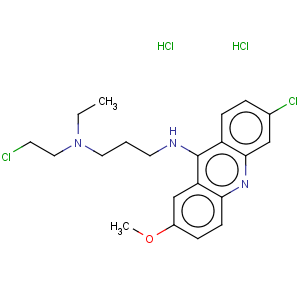
- .Sign In | Join Free
Sourcing large orders? Visit VVchem.com

| Product Name: | 1,3-Propanediamine,N1-(2-chloroethyl)-N3-(6-chloro-2-methoxy-9-acridinyl)-N1-ethyl-, hydrochloride(1:2) |
| CAS Registry Number: | 146-59-8 |
| EINECS: | 205-675-7 |
| Synonyms: | 2-Methoxy-6-chloro-9-[3-[ethyl(2-chloroethyl)amino]propylamino]acridinedihydrochloride;2-Methoxy-6-chloro-9-[3-(ethyl-2-chloroethylamino)propylamino]acridinehydrochloride; Acridine,6-chloro-9-[[3-[(2-chloroethyl)ethylamino]propyl]amino]-2-methoxy-,dihydrochloride (7CI,8CI); ICR 170H;1,3-Propanediamine,N1-(2-chloroethyl)-N3-(6-chloro-2-methoxy-9-acridinyl)-N1-ethyl-, hydrochloride(1:2);1,3-Propanediamine,N-(2-chloroethyl)-N'-(6-chloro-2-methoxy-9-acridinyl)-N-ethyl-, dihydrochloride(9CI); ICR 170; Acridine mustard; |
| Molecular Structure: |
 |
| Molecular Formula: | C21H25 Cl2 N3 O . 2 Cl H |
| Molecular Weight: | 479.31 |
| Density: | g/cm3 |
| Boiling Point: | 546.9°Cat760mmHg |
| Melting Point: | 231-232 °C |
| Flash Point: | 284.5°C |
| Risk Codes: | 68-40-23/24/25 |
| Safety Statements: | Poison by intravenous and intraperitoneal routes. Questionable carcinogen with experimental neoplastigenic data. Experimental reproductive effects. Human mutation data reported. When heated to decomposition it emits toxic fumes of NOx and HCl. |
| Hazard Symbols: | T: Toxic; |